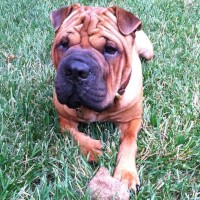Appearance of the Bull-Pei
|
| The hybrid of the Bulldog and Shar Pei is a square-bodied dog of medium to large size, with powerful muscles, a thick neck and powerful jaws. Their heads are larger than average for their body size, with a muzzle that can vary between the broad, flat muzzle of the Bulldog and the substantial medium-length muzzle of the Shar Pei breed. They have small eyes that sit low on the face and triangular ears that sit high on the head and fold flat, either in front of the face or to the sides. Bulldog and Shar Pei wrinkles, but Shar Pei wrinkles are a little more dramatic, and the Bull-Pei will probably inherit this trait too. They have short, straight, single-ply coats, although depending on which side of the family they prefer, these hairs can be fine-textured and lie flat against the body, or they can come straight off the body with an extremely coarse texture. |
Temperament of the Bull-Pei
|
| The Bull-Pei is generally a fairly placid animal that is happiest when spending time with its family. They tend to have a confident air about them and can become a little territorial. Most Bull-Peis will get on very well with children due to the Bulldog side of their heritage, however, Shar Peis are not always tolerant of children and some Bull-Peis will inherit this temperament instead. All interactions with young children should be supervised, as these animals are quite powerful. Socialization is essential with this crossbreed to avoid anxiety or aggression, as unsocialized Bull-Peis are much more likely to act aggressively and lash out at another animal or stranger than their properly socialized counterparts. This dog may be more likely to chase small pets than other dogs. This dog should also be fairly easy to train, although you may come across Bulldog and Shar Pei mixes that are a little more stubborn than most. |
Needs and activities of the Bull-Pei
|
| Neither the Shar Pei nor the Bulldog has very high exercise requirements, and the Bull-Pei will also be happy with several short exercise sessions throughout the day. The Bull-Pei can also be more sensitive to weather problems, so precautions should be taken when exercising in very hot or very cold weather. They don't usually bark frequently, but it's certainly noticeable when they do, and they tend to snore quite loudly. These dogs tend to prefer a yard for sniffing, but they can also be quite content in an apartment, as long as they're close to their family. |
Maintenance of the Bull-Pei
|
| When it comes to grooming, these dogs are pretty easy to manage. The short coat of this hybrid is quite manageable and although they require regular brushing with a curry comb or soft bristle brush to control shedding and distribute body oils, monthly baths are usually sufficient for these dogs. Care must be taken to ensure that skin folds are not trapped with moisture or dirt, as this could lead to skin irritation and a foul odor. Medicated shampoo may be necessary if skin disorders such as pyoderma folds or scabies develop, and the face and muzzle area should be examined and wiped down once a week to avoid red yeast and other fungal or bacterial infestations. |









 English (United Kingdom)
English (United Kingdom)